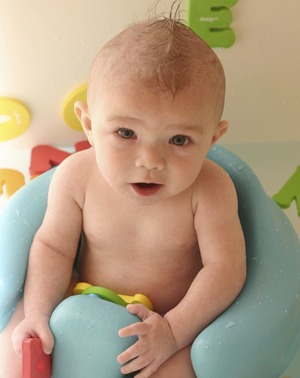Child Proof Your Home
By Megan H. Smith

Ah, the delightful sounds of young children: the pitter-patter of little feet, the peals of delighted laughter, those wonderful first words, and the unmistakable sound of the toilet filling up and overflowing with water after a small child decides to try to flush her new shoes.
Babyproofing and child proofing your home is vitally important on two levels. First, it can help maintain your sanity, but second, and most important, it can prevent accidents and injuries and keep your little bundles of joy safe from harm. Consider these statistics:
• Injury is the leading cause of death in children and young adults. The latest numbers from the CDC show that 2800 children, ages one to fourteen, died from unintentional injury in 2005.
• Falls are the leading cause of unintentional injury.
• Drowning is the second leading cause of unintentional injury among children ages one to fourteen. Most drownings occur in swimming pools and in open water, but children can drown in as little as one inch of water.
• Airway obstruction is the leading cause of unintentional injury-related death in children under age one.
• Approximately 45 percent of unintentional injury deaths occurred in and around the home. These deaths are caused primarily by fire and burns, suffocation, drowning, firearms, falls, choking and poisoning.
While these statistics may seem daunting, even frightening to a new parent, they illustrate that in many cases, childhood injury and death are preventable. By thoroughly examining your home and employing simple methods and products, you can create a safe haven for your children and prevent an accident from occurring right under your nose.

One of the easiest and first things a new parent can do is to walk – or crawl – around the house, and examine the environment from a child’s perspective. From this level, you will be able to see hazards you might otherwise miss when looking from above. Unused electrical outlets are easily covered with inexpensive plastic plug covers, and if your child is extraordinarily deft and can figure out how to remove them, special outlet plates can be installed which are much harder to crack. Covers are also available for outlet strips, and cords can be bundled and secured to prevent tripping or pulling.
As you move around the home, keep an eye out for small objects, which any curious baby will want to examine by putting in her mouth. Choking is a serious hazard, and can be prevented with just a little vigilance. Any object that is small enough to fit through a 1 1⁄4 inch circle or is less than 2 1⁄4 inches long is too small to be safely handled by a child under the age of four. Check the floor, under furniture, and on low shelves for items such as coins, marbles, watch batteries, pen caps, toys with small, removable parts, rubber bands, and uninflated or broken balloons. One of the most common causes of choking incidents is food, so apply the size rule to your kitchen as well, keeping nuts and small candies out of reach.
As little ones learn to stand and walk, they will rely on furniture to pull themselves upright and steady them as they take their first steps. Adventurous walkers may turn into climbers, turning a chest of drawers into a toddler-sized staircase. Secure all large, heavy pieces of furniture to the walls with straps mounted into wall studs.
You will undoubtedly want to limit baby’s access to various rooms in your house, particularly if you have stairs, so get ready to go baby-gate shopping. You know those wooden ones that people with small dogs always have around, the ones that never seem to fit securely in a doorway and manage to trip all the guests? Don’t get one of those. There are many pressure-mounted gates on the market that do work, and are even openable for easy access for adults. Wall-mounted gates are also available for extra security.
The bathroom can be full of hazards for an unattended child, so keep a close eye on your kids whenever they are taking a bath. Leaving the room, even for a moment, can be disastrous, since children can drown quickly. Set your water heater to 120 degrees, and use a bath thermometer to ensure the water never gets above 100 degrees for baby’s bath. Keep cleaning products, soaps, and cosmetics out of reach, use a non-slip bath mat in the tub, and install a toilet lid lock to keep shoes out of your plumbing.
This is by no means an exhaustive list, but can help you get an idea of how to start. Limiting access to dangerous things and places and removing potential hazards may seem like a gargantuan task at first, but the products available today make the job much easier – and the rewards are immeasurable. To see all the great products that are available for babyproofing your home, check out the One Step Ahead catalog online at www.OneStepAhead.com. Baby gates in all their permutations can be checked out at – you guessed it - www.BabyGates.com, where they even have a handy Gate Selection Wizard to help you choose the right gate for your needs. Finally, check out the Home Safety Council site at www.HomeSafetyCouncil.org, where they have tons of information and advice about keeping your kids – and you – safe in your home.
Back
|

